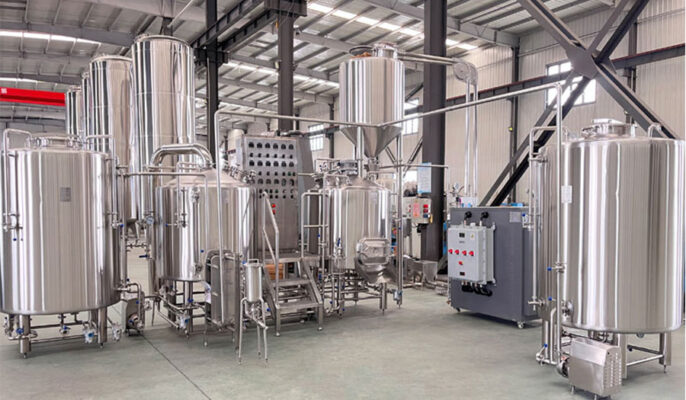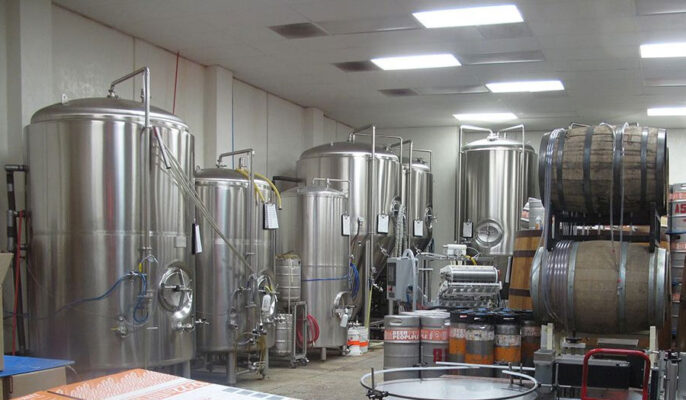Negli ultimi anni l'industria della birra artigianale ha conosciuto un vero e proprio boom, con un numero sempre maggiore di appassionati che hanno portato la loro passione per la birra di qualità al livello successivo, avviando un microbirrificio. In questa guida esamineremo in modo approfondito i costi di avviamento di un microbirrificio ed esploreremo le fasi e i costi essenziali per trasformare i vostri sogni di birra in realtà.
Che cos'è un microbirrificio?
Un microbirrificio è un'attività di produzione di birra su piccola scala che produce quantità limitate di birra artigianale. A differenza dei grandi birrifici commerciali, i microbirrifici si concentrano sulla qualità, sull'innovazione e sull'arte della produzione. Spesso si rivolgono a mercati di nicchia, offrendo sapori unici e birre che rispondono a gusti specifici. La popolarità dei microbirrifici è aumentata per diversi motivi. I consumatori sono sempre più alla ricerca di prodotti autentici e locali, e i microbirrifici si inseriscono perfettamente in questa tendenza.

Come si apre un microbirrificio?
Determinare il mercato di riferimento
Prima di considerare i costi di avviamento, è fondamentale condurre un'accurata ricerca di mercato e sviluppare un solido business plan. L'identificazione del vostro mercato di riferimento vi aiuterà a determinare il tipo di birra che volete produrre, le dimensioni della vostra attività e la migliore strategia per coinvolgere il vostro pubblico: fate ricerche sui dati demografici locali, sulle tendenze attuali del settore e sulla concorrenza per prendere decisioni informate.
Requisiti legali e di licenza
I piccoli birrifici devono rispettare le normative federali, tra cui l'ottenimento di un avviso di birrificazione da parte dell'Alcohol and Tobacco Tax and Trade Bureau (TTB). Occorre inoltre considerare i requisiti di garanzia e le approvazioni per l'etichettatura. Assicuratevi di mettere in preventivo questi costi, oltre ad eventuali onorari professionali associati alla gestione di un ambiente normativo complesso.
Considerazioni sulla posizione e sullo spazio
La scelta della sede giusta è fondamentale per il successo del vostro piccolo birrificio. Discuteremo i fattori da considerare quando si sceglie lo spazio giusto per la propria attività.
Attrezzature e forniture per la produzione di birra
Il cuore di ogni piccolo birrificio è l'attrezzatura per la produzione di birra. Vi presenteremo le attrezzature e le forniture di base per la produzione di birra di cui avrete bisogno per avviare la vostra attività.
Personale e formazione
Un team ben formato ed entusiasta è essenziale per produrre un'ottima birra. Parleremo di come assumere le persone giuste e fornire loro la formazione necessaria.
Costi di avvio del microbirrificio
- Costi delle micro-attrezzature: L'investimento nella giusta attrezzatura per la produzione di birra può comportare una spesa iniziale significativa. Vi forniremo informazioni sui costi associati all'acquisto o al leasing di macchinari per la produzione di birra.
- Costi per permessi e licenze: La conformità ai requisiti di legge spesso richiede dei costi. Informatevi sui costi da sostenere per ottenere le licenze e i permessi necessari per il vostro microbirrificio.
- Affitto e utenze: Assicurarsi una sede adatta e gestire le bollette può aumentare i costi di avviamento. Scoprite come prevedere queste spese ricorrenti.
- Budget di marketing e promozione: Il marketing è essenziale per il successo in un mercato competitivo. Vi guideremo nell'allocazione dei budget per implementare strategie di marketing e promozione efficaci.
- Altre spese: Ci sono molte altre spese da considerare. Dall'assicurazione ai costi delle materie prime iniziali, vi aiuteremo a creare un budget completo.
Selezione del materiale delle attrezzature per microbirrifici
Attrezzature per la produzione di birra in rame
Le attrezzature per la produzione di birra in rame sono state utilizzate per secoli nella produzione di birra grazie alla loro struttura. Muove il calore nella pentola in modo rapido e uniforme per cuocere a vapore il mosto. Di solito si inizia a produrre birra con utensili in rame perché è molto adatto per la cottura a vapore del mosto ad alte temperature. Il rame tende a reagire rapidamente con altre sostanze chimiche e a produrre un sapore metallico nella birra. Diverse procedure di pulizia e disinfezione possono modificare il colore della birra prodotta con pentole di rame.
Attrezzature per la birra in acciaio inox
Al giorno d'oggi ci si concentra sul prodotto finito e tutti i grandi birrifici industriali utilizzano attrezzature per la birra in acciaio inox. I serbatoi utilizzati non sono completamente in acciaio inox, e su ogni serbatoio è presente un rivestimento in rame per garantire un aspetto naturale, ma che non interferisce con il gusto a meno che non venga sbiancato. L'acciaio inossidabile non reagisce attivamente con le sostanze chimiche, ma tende a reagire con il cloro, quindi una disinfezione adeguata non influisce sulla qualità della birra prodotta con attrezzature in acciaio inossidabile. L'acciaio inox è un materiale più robusto del rame, quindi non causerà stress quando si vaporizza il mosto ad alte temperature. Sarà una scelta duratura per il birrificio.
Costi delle attrezzature per microbirrifici
L'attrezzatura è di solito il costo maggiore che si incontra quando si avvia un birrificio. Le attrezzature per la produzione di birra di piccola capacità (1 fusto, che produce 320 barili di birra da 12 once) possono spesso essere acquistate nuove o usate per $100.000 o meno. Tuttavia, per un grande sistema di produzione da 30 barili, in grado di produrre 9.600 bottiglie di birra da 12 once, si può arrivare a pagare fino a $1 milione.
Sia che si acquisti nuovo o usato, l'attrezzatura tipica necessaria per iniziare a produrre birra comprende:
Attrezzature per la produzione di birra
- Sistemi di produzione della birra: Comprendono pentole, serbatoi per il mosto, serbatoi di fermentazione e altro ancora. Queste apparecchiature sono di solito il cuore della produzione di birra e la loro qualità e capacità influiscono direttamente sulla capacità di produzione e sulla qualità della birra.
- Sistema di raffreddamento: utilizzato per controllare la temperatura durante il processo di fermentazione per garantire una temperatura stabile e controllata durante la fermentazione della birra.
- Apparecchiature di riempimento: utilizzate per riempire la birra in bottiglie, lattine o fusti, tra cui macchine di riempimento, sigillatrici e così via.
- Pulizia e sanificazione delle attrezzature: Mantenere l'igiene delle attrezzature e dei contenitori è fondamentale per la sicurezza della produzione e la qualità della birra.

Attrezzature di supporto
- Caldaie: forniscono vapore o acqua calda per il riscaldamento dell'acqua di fermentazione e del luppolo.
- Compressori d'aria: utilizzati per azionare apparecchiature ad aria compressa, come macchine per il riempimento e la sigillatura.
- Apparecchiature per il trattamento dell'acqua: assicurano che l'acqua utilizzata nel processo di produzione della birra sia conforme agli standard.
Attrezzatura per la fermentazione
- Apparecchiature di controllo della fermentazione: comprendono termoregolatori e raccordi per fermentatori per monitorare e controllare la temperatura e altre condizioni durante il processo di fermentazione.
- Attrezzature per lo stoccaggio e la maturazione: utilizzate per conservare la birra finita, compresi i serbatoi o i fusti.
Attrezzature e strumenti ausiliari
- Mulino per malto: macina il malto in una polvere adatta alla produzione di birra.
- Apparecchiature per la coltura del lievito: utilizzate per coltivare e mantenere i ceppi di lievito.
Le dimensioni di un microbirrificio
Le dimensioni del birrificio sono il fattore principale che determina il costo delle attrezzature per microbirrifici. Se avete un'attività più grande, avrete bisogno di attrezzature più grandi e di un birrificio più grande. Un birrificio è dotato di un miscelatore di mosto, di un serbatoio per la birra calda, di un whirlpool, di un bollitore e di un lauter tun. Di solito, la capacità di un birrificio è determinata in barili per barile (BBL). Micet Group produce birrifici di diverse capacità a seconda delle esigenze dei clienti.




